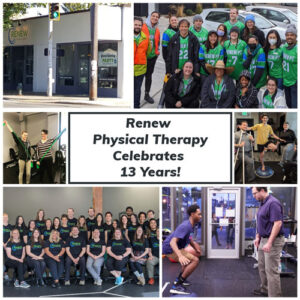This year, Renew Physical Therapy is celebrating its 13th anniversary! As we reflect on our journey, let’s take a trip back to 2012 and explore how much the field of physical therapy has evolved. It’s been an exciting ride, not only for physical therapy but for the world at large. Let’s rewind to 2012 and see what the physical therapy world looked like then versus now!
2012: The World & Physical Therapy Landscape
In 2012, the world was still jamming to Carly Rae Jepsen’s Call Me Maybe, The Hunger Games was making waves at the box office, and the iPhone 5 was the latest tech innovation. Meanwhile, in physical therapy, a lot was going on:
- Direct Access Limitations: In 2012, many states still required a referral from a doctor before seeing a physical therapist. Fast-forward to today, and we now have direct access in all 50 states, making it much easier for patients to receive care when they need it, without unnecessary delays.
- Paper Documentation: Back in 2012, many physical therapists were still jotting down notes on paper. EMRs (electronic medical records) were on the rise, but much of the industry was still transitioning. Today, we have streamlined digital documentation, with AI-assisted tools that save time and enhance care.
- Treatment Techniques: The field in 2012 was still heavily focused on passive treatments like ultrasound and heat therapy. Fast-forward to now, physical therapists focus more on active movement, strength training, and functional exercises that get patients back to their daily lives faster.
- Wearables & Tech: 2012 was a pivotal year for wearable fitness tech, as Fitbit launched its first activity tracker. While wearable technology was still in its infancy, it paved the way for physical therapists to begin integrating smart tools like motion trackers and biofeedback devices to enhance patient care.
Flashback Fun: Physical Therapy Fads Then vs. Now
When it comes to trends in physical therapy, some things come and go, while others evolve. Here’s a quick look at how things have changed in the last 13 years:
- Then: Static stretching was everywhere, with many physical therapists relying on the old-school method of 30-second timers and stretching on the table.
Now: We focus on more dynamic stretching techniques that incorporate movement and improve flexibility, like active release stretches and mobility drills. Movement is the best way to “warm up” your muscles! - Then: Ice packs and heating pads were the go-to for recovery, with the “R.I.C.E.” method (Rest, Ice, Compression, Elevation) being the standard post-injury protocol.
Now: While still used, modalities like contrast therapy (hot/cold contrast) and cryotherapy have taken off, offering more targeted and quicker recovery options. More emphasis is being placed on earlier movement to reduce swelling and promote healing. - Then: Transcutaneous electrical nerve stimulation (TENS) units were widely used in the clinic for pain relief.
Now: We now use more advanced technology like dry needling and electrical stimulation devices that target specific muscles for faster, more efficient healing.
Looking Ahead
If the past 13 years have taught us anything, it’s that physical therapy is always evolving. Who knows what advancements we’ll see by 2037? Maybe virtual reality rehab will be the norm, or AI-driven movement analysis will be as common as therabands. Whatever the future holds, we’re excited to continue innovating, growing, and providing top-notch care to our community.
Here’s to the next 13 years of progress, teamwork, and helping people move better than ever!







